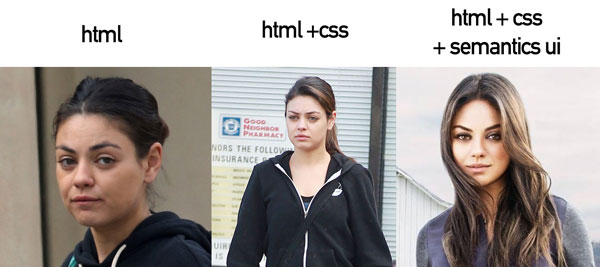Web development made easy
21 Feb 2019
What the heck is the point of a framework
During my Spring 2019 semester, I was introduced to HTML and CSS and the world of web and app development. I’ve always thought of those languages to be particularly difficult, and using them to create high-quality websites that are functional was an enormous task and quite time-consuming. I worked with just HTML and CSS, creating simple and basic webpages, for a week before being introduced to a UI framework. That one week was exceedingly boring, as the only things that I was able to muster were primitive looking websites that belonged on the 1990s. I personally wasn’t happy with what I created and I craved for more. The coming week introduced me to my first UI framework, Semantic UI. I was taken by storm as to how easy it was to create a gratifying website that was nice to look at. Just loading the Semantic UI framework into the HTML file that held the primitive website, instantly made the website that I initially created into a much more modern and soft looking website, that in my opinion, could be published. In my short time using Semantic UI, I found it to be a necessary component in any web development toolset, as using raw HTML and CSS to create some things that Semantic UI provides would be very difficult and much harder without a framework.
Why learn a framework like Semantic?
I was told by my professor that using raw HTML and CSS to accomplish tasks that would fit the bill of most modern day websites would be futile and time-consuming. Having a framework at your disposal is like having that one card in a poker match that makes or breaks the current hand. They allow the user to easily create simple and not so primitive looking websites. Personally, I tend to look at Semantic UI as a puzzle, I take a lot of interest in scrolling through each different element that Semantic UI provides and figuring out how each piece can fit into the requirements of a coding homework or a project. Working the puzzles, though not literal ones, of website creation, is particularly interesting, and I enjoy finding the parts of a website and making it all come together. With that, learning a framework can be very beneficial and hard, as it opens up a chest of knowledge to use as well as requires a bit more learning and understanding. Using a UI framework gives the user components to use in website creation that are easy and fluid to use, rather than using HTML and CSS to accomplish it, and without a framework, a project could require you to know how to make the components of a website from scratch AND where to use them AND how to use them appropriately. Having said that, using a framework reduces one very large step in the creation of a website and allows for more time to be devoted to the tidbits of the website, rather than trying to get everything on the screen and then having to make sure every piece of HTML and CSS code that is written works together and works as intended.